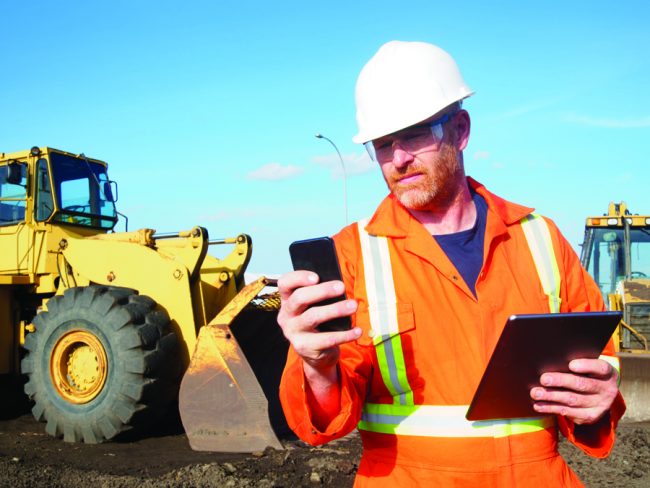
Construction 2.0: Technology is changing construction, the industry must change with it
By Paul Struthers
Construction Green Construction Health & Safety Infrastructure Software
Work sites generate a prodigious amount of data that can be used to streamline operations. PHOTO: Getty Images
The construction industry in Canada is experiencing a transformation. New technologies tailored to the space are creating greater efficiency, but labour gaps are increasing, access to capital is shrinking and a trade war with the U.S. has begun. To adapt to this changing landscape, all parties involved in construction need to become more connected.
As a major industry for Canada, construction is already near its capacity utilization rate. Referencing a report from Statistics Canada, Bloomberg recently pointed out that the construction industry’s capacity utilization reached 92.4 percent in the first quarter of 2018. In order to sustain this, the industry must go through its own remodel—one that leans on information as its lead material.
Data is king when it comes to managing a successful construction project, with the amount of information digitally recorded on construction sites growing exponentially over the last 10 years. From job site photos and information on materials used to track labour hours and equipment utilization data, the ability to capture information without the worry of a paper trail is a driving force for change.
Construction sites are no longer simply a place for diggers, bricks and concrete; they are changing the world—physically and theoretically. As a hotbed of all sorts of data, construction sites are being leveraged to drive operations and improve efficiencies in the industry.
Take field data tracking, for instance. What used to be a tedious and manual process that involved clipboards and filing cabinets has become streamlined through mobile, cloud and big data analytics technologies so that users can capture and analyze the data in near real-time. The digitization of that process now means construction workers can easily gather and share data with key stakeholders, both on-site and back at headquarters, using a range of tools including apps, smartphone cameras, drones and even robots.
Modern construction sites are collecting data through mobile devices as a strategy for success for today’s digital age. Information reported and accessed using handheld equipment is no longer seen as a “nice to have,” but rather a valuable resource to help firms stay competitive and understand how resources can be better leveraged to get work done.
AI for actionable intelligence on the job site
The mass adoption of digital techniques, and the transition to a digital economy is also playing an important role in transforming the construction industry. By facilitating better planning and preparation for “what if” scenarios, construction companies are looking to technology to help make projects more profitable.
Historically, information has been stored in myriad different places—floppy disks, compact discs, USBs, spreadsheets and even the human brain. But as data volumes become larger and the demand for actionable intelligence from these receptacles of information grows, the need for adequate capturing and processing techniques will also increase.
For example, in 2010, 1.2 zetabytes (one trillion gigabytes) of data were collected from smart building sites worldwide. By 2020, that figure is projected to be a massive 37.2 zetabytes. Processing massive volumes of data to provide actionable insights is the perfect use case for machine learning and Artificial Intelligence (AI), as it allows human manpower to focus on what really matters. Linking man with machine will provide the construction industry with formerly hidden insights into data that would have previously taken weeks or months to process and find value in otherwise.
Technology should be seen as an ally, not a replacement
By enabling new levels of efficiency when it comes to data processing, AI can complement and enhance many job opportunities for today’s workforce. Too often, artificial intelligence is perceived as a monumental threat to human jobs. In reality, the use of AI can enable businesses to become more productive—allowing employees more time to expand on their skillsets. For the construction industry specifically, AI presents an opportunity to optimize processes and improve results.
Focus on integration
The key to getting the most out of emerging technologies is integrating them effectively with the company’s existing systems, processes and human counterparts.
Technology is only ever as good as its ecosystem. This means we need to see closer coordination between the back office, vendors and those in the field. Implemented effectively, businesses will benefit from both greater transparency and fluidity with their information. This will help ensure that decisions can be made at the appropriate levels within the organization, so that the back office can concentrate on strategy rather than tactical planning.
For construction, it’s all about embracing the benefits of new technologies and creating a plan for using them in a way that complements the workforce, rather than replacing it. With increased communication and faster response times, business growth and world-class customer service can be possible.
 Paul Struthers is the executive vice-president and managing director of Sage Canada.
Paul Struthers is the executive vice-president and managing director of Sage Canada.
Mr. Struthers is responsible for Sage’s overall business in Canada, working alongside Sage’s network of customers, partners, and accountants. He is also an avid champion for Canadian business builders.




